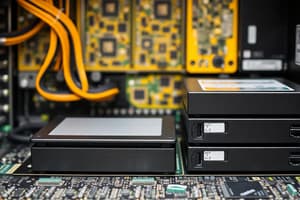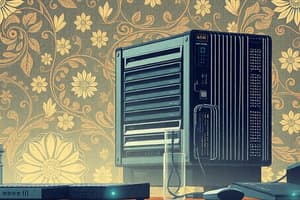Podcast
Questions and Answers
What is the primary purpose of output devices?
What is the primary purpose of output devices?
- To store data for future use
- To perform calculations on data
- To display or provide data from the computer (correct)
- To connect computers over a network
Which of the following correctly describes a Wide Area Network (WAN)?
Which of the following correctly describes a Wide Area Network (WAN)?
- Interconnects computers over a larger geographic area (correct)
- Connects computers within a home or office
- Is limited to one specific organization or entity
- Only functions locally without internet access
Which statement accurately describes a 'bit' in data representation?
Which statement accurately describes a 'bit' in data representation?
- A bit is made up of 4 bytes
- A bit represents the smallest unit of data (correct)
- A bit can only be a number
- A bit is a group of characters
What is the role of compilers in software development?
What is the role of compilers in software development?
Which of the following is considered a type of system software?
Which of the following is considered a type of system software?
Which of the following best describes the role of an operating system?
Which of the following best describes the role of an operating system?
What characteristic distinguishes Random Access Memory (RAM) from storage devices?
What characteristic distinguishes Random Access Memory (RAM) from storage devices?
Which component of the Central Processing Unit (CPU) is primarily responsible for executing instructions?
Which component of the Central Processing Unit (CPU) is primarily responsible for executing instructions?
Which of the following is NOT a function of an operating system?
Which of the following is NOT a function of an operating system?
What is the primary advantage of Solid State Drives (SSDs) over Hard Disk Drives (HDDs)?
What is the primary advantage of Solid State Drives (SSDs) over Hard Disk Drives (HDDs)?
What type of memory is used in RAM to store data temporarily while the computer is in use?
What type of memory is used in RAM to store data temporarily while the computer is in use?
Which of the following correctly identifies input devices?
Which of the following correctly identifies input devices?
What is an example of processed data that has meaning?
What is an example of processed data that has meaning?
Flashcards
What is the Internet?
What is the Internet?
A global network of interconnected computers, enabling communication and access to information across the world.
What is application software?
What is application software?
Software designed for specific tasks, such as word processing, gaming, or web browsing.
What is character encoding?
What is character encoding?
A system of representing characters (letters, numbers, symbols) using binary code (0s and 1s).
What is system software?
What is system software?
Signup and view all the flashcards
What is cybersecurity?
What is cybersecurity?
Signup and view all the flashcards
Hardware?
Hardware?
Signup and view all the flashcards
Software?
Software?
Signup and view all the flashcards
Data?
Data?
Signup and view all the flashcards
Information?
Information?
Signup and view all the flashcards
What is an operating system (OS)?
What is an operating system (OS)?
Signup and view all the flashcards
What is a Central Processing Unit (CPU)?
What is a Central Processing Unit (CPU)?
Signup and view all the flashcards
What is Random Access Memory (RAM)?
What is Random Access Memory (RAM)?
Signup and view all the flashcards
Study Notes
Fundamental Concepts
- Hardware: The physical components of a computer system, including the CPU, RAM, storage devices (hard drives, SSDs), input devices (keyboard, mouse), and output devices (monitor, printer).
- Software: The set of instructions that tells the hardware what to do. This includes operating systems (like Windows, macOS, Linux), applications (like word processors, web browsers, games), and programming languages (used to create software).
- Data: Raw facts and figures, or symbols that can be processed by a computer. This can be text, numbers, images, audio, or video.
- Information: Processed data that has meaning and can be used to make decisions or take actions. This transforms raw data into something useful.
Operating Systems (OS)
- Role: Acts as an intermediary between the user and the hardware, managing the resources of the computer and allowing other software to run.
- Key Functions:
- Managing computer resources (CPU, memory, storage)
- Providing a user interface (GUI or command-line)
- Running applications
- Handling input and output operations
- Security (access control, authentication)
- Examples: Windows, macOS, Linux (and various distributions).
Central Processing Unit (CPU)
- Function: The "brain" of the computer, responsible for executing instructions.
- Components: Control unit (CU) and arithmetic logic unit (ALU).
- Speed: Measured in gigahertz (GHz). Higher GHz generally means faster processing.
- Multi-core: Modern CPUs often have multiple cores, enabling parallel processing (doing multiple tasks at once).
Random Access Memory (RAM)
- Function: Stores data and instructions that the CPU is currently using.
- Characteristics: Volatile memory—data is lost when the power is turned off.
- Capacity: Measured in gigabytes (GB). More RAM generally allows for running more programs simultaneously without slowing down.
Storage Devices
- Hard Disk Drives (HDDs): Magnetic storage that is relatively inexpensive but slower than SSDs.
- Solid State Drives (SSDs): Use flash memory and are significantly faster but more expensive than HDDs.
- Types: SATA, NVMe.
- Cloud Storage: Storing data on remote servers accessible via the internet.
Input and Output Devices
- Input Devices: Allow users to give data to the computer (keyboard, mouse, scanner, microphone).
- Output Devices: Show or provide data from the computer (monitor, printer, speaker).
Networks
- Local Area Networks (LANs): Connect computers within a limited area (e.g., a home, office).
- Wide Area Networks (WANs): Connect computers over a larger geographic area (e.g., the internet).
- Internet: A global network of interconnected computers.
Data Representation
- Binary System: Computers use binary code (0s and 1s) to represent all data.
- Bits and Bytes: A bit is the smallest unit of data, a byte is 8 bits.
- Character Encoding: Systems for representing characters (letters, numbers, symbols) in binary code. (e.g., ASCII, Unicode)
Software Development
- Programming Languages: High-level languages (Python, Java, C++) allow programmers to write instructions for computers in a human-readable format.
- Compilers and Interpreters: Translate these high-level codes into machine code that the CPU can execute.
- Software Development Life Cycle (SDLC): A process that guides the creation of software, from planning to testing.
Cybersecurity
- Importance: Protecting computer systems and data from unauthorized access, use, disclosure, disruption, modification, or destruction.
- Threats: Viruses, malware, phishing, hacking, denial-of-service attacks.
- Protection: Firewalls, anti-virus software, strong passwords, secure coding practices.
Types of Software
- System Software: Controls the computer hardware (Operating Systems).
- Application Software: Programs designed for specific tasks (word processors, games).
Studying That Suits You
Use AI to generate personalized quizzes and flashcards to suit your learning preferences.




